Choosing the right flat roofing system is critical for your property in San Antonio, TX given the area’s warm climate and weather variations. Built-Up Roofing (BUR), TPO, and EPDM are among the top flat roofing solutions, each offering unique benefits suited to different property needs. With their specific advantages, these roofing materials cater to durability, energy efficiency, and low maintenance. At Shield Roofing, we bring over 25 years of expertise to guide you in selecting the roofing system that ensures lasting protection for your property.
Understanding Flat Roofing Systems: Built-Up, TPO, and EPDM
Flat roofing systems provide excellent options for property owners seeking durable solutions in San Antonio. Built-Up Roofing, TPO, and EPDM stand out among roofing materials, each designed to meet varying needs for longevity and performance.
From Built-Up Roofing’s multi-layer approach to TPO’s reflective surface optimizing energy savings, and EPDM’s weather resistance, these systems are tailored for flat roofing requirements. By understanding their unique characteristics, you can identify the roofing system that best aligns with your property’s demands for durability and low maintenance.
What Is Built-Up Roofing (BUR)?
Built-up roofing (BUR) consists of multiple layers of materials, including asphalt and felt, creating a durable and weather-resistant roof system. Commonly used for flat roofs, BUR offers excellent insulation and waterproofing properties, making it a popular choice for commercial and industrial buildings.
What Is TPO Roofing?
TPO, or Thermoplastic Olefin, is a single-ply membrane known for its energy efficiency and reflective properties. Made from a blend of polypropylene and ethylene-propylene rubber, it provides durability and ease of installation, making it a popular choice for flat roofs in various climates.
What Is EPDM Roofing?
EPDM (ethylene propylene diene monomer) is a durable, synthetic rubber roofing membrane widely used for flat roofs. Known for its exceptional weather resistance and UV stability, EPDM offers long-lasting protection and energy efficiency, making it a popular choice for both residential and commercial buildings.
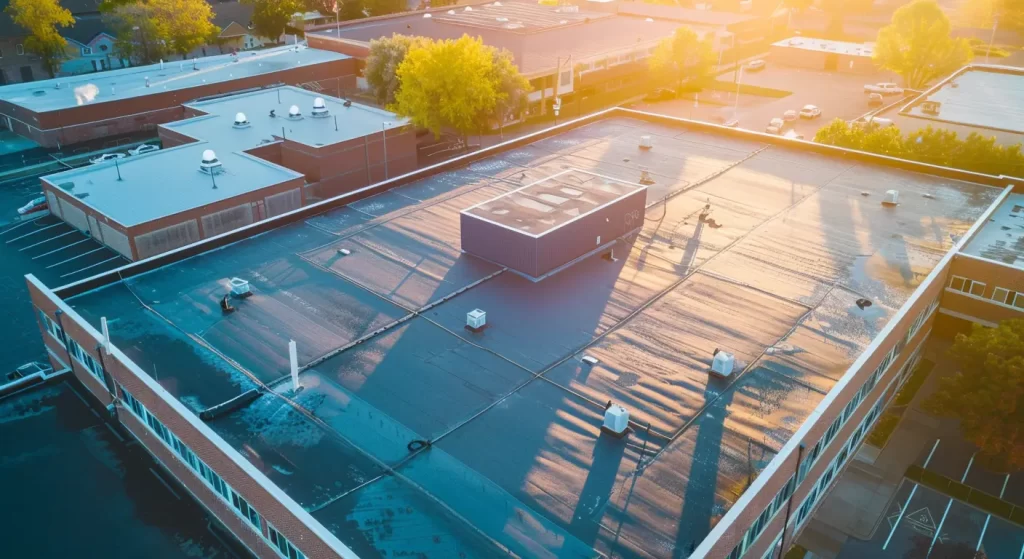
Pros and Cons of Built-Up Roofing
Built-Up Roofing (BUR) offers incredible durability and excellent performance in intense weather conditions. It provides reliable insulation and energy savings, which are particularly valuable in warm climates like San Antonio.
However, BUR’s drawbacks include a higher initial cost and longer installation time due to its labor-intensive construction process. It can also be heavier than other flat roofing materials, making it unsuitable for certain buildings. These trade-offs highlight the importance of consulting with Shield Roofing to determine if BUR fits your property’s requirements.
Advantages of Built-Up Roofing for San Antonio Homes
A multilayered built-up roofing (BUR) system delivers outstanding performance for San Antonio homes, particularly in extreme weather. Its durable asphalt and reinforcing materials offer excellent UV resistance and temperature durability. BUR effectively manages water pooling, crucial for preventing leaks during heavy Texas rains.
Moreover, this option enhances energy efficiency with superior insulation, reducing summer energy bills thanks to its thermal mass. Its versatility allows for easy maintenance and quick repairs. Overall, BUR is a wise choice for homeowners aiming to protect their investment against Texas climate challenges.
Drawbacks of Built-Up Roofing to Consider
Despite its advantages, Built-Up (BUR) has drawbacks that property owners should consider. The labor-intensive application requires skilled professionals, resulting in higher costs than alternative systems. BUR’s weight may also necessitate structural modifications for some buildings.
Temperature fluctuations can affect the materials over time, potentially compromising integrity. Regular maintenance is needed to address issues like surface cracking and extreme weather effects. While BUR is durable, these factors can impact long-term performance when compared to TPO and EPDM options.
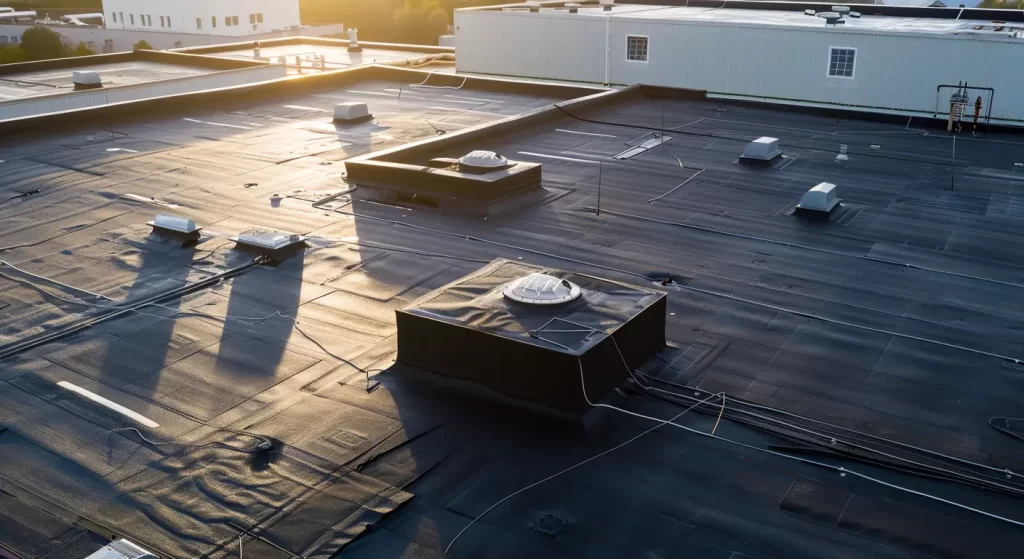
Pros and Cons of TPO Roofing
TPO combines energy efficiency and affordability, making it a strong flat roofing contender in regions like San Antonio. The bright white surface reflects sunlight, reducing cooling costs for long-term energy savings.
However, the variable product quality between brands and durability concerns in extremely cold climates are aspects property owners should heed. Proper installation ensures its heat-welded seams deliver robust leak resistance.
Benefits of TPO Roofing for Flat Roofs
Thermoplastic olefin (TPO) is an excellent choice for flat roofs, offering energy efficiency and weather resistance. Its bright white surface reflects UV radiation, lowering energy bills in warm climates while enhancing indoor comfort.
Additionally, TPO’s easy installation and strong seams reduce labor costs and ensure durability, resulting in low maintenance over the roof’s lifespan, including being 100% recyclable at the end of its life cycle. Choosing the right material can be challenging, but TPO’s performance makes it a smart option for any flat roofing project.
Potential Challenges with TPO Roofing
TPO roofs present various challenges for flat roof projects. While thermoplastic olefin offers excellent energy efficiency and reflectivity, its longevity can be compromised by extreme weather and prolonged UV exposure, leading to membrane degradation.
Proper installation is vital; any errors can cause issues like seam separation. Although TPO is generally cost-effective, higher upfront costs may deter property owners seeking short-term savings. Additionally, limited color options compared to EPDM can restrict aesthetic choices for commercial buildings.
Understanding these factors is crucial for building owners seeking a sustainable, durable solution.
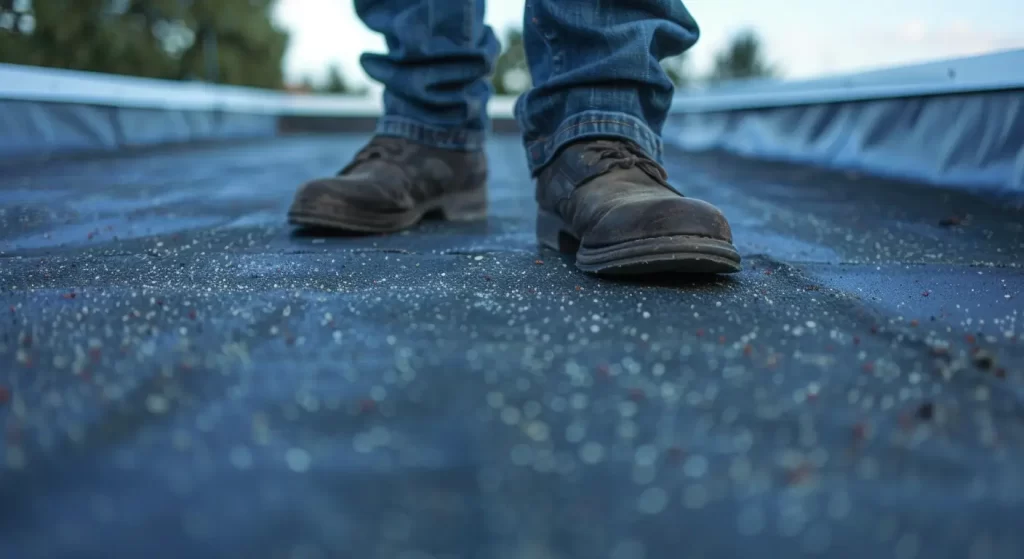
Pros and Cons of EPDM Roofing
The advantages of EPDM lie in its durability and weather resistance, making it a suitable choice for commercial buildings in varying climates. Its synthetic rubber membrane is effective against UV radiation, contributing to energy efficiency and potential energy savings for property owners. However, a higher initial cost may deter some, and while it performs well under most conditions, it could struggle with extreme weather events. Understanding these key differences helps building owners make informed decisions regarding their flat roofing systems.
Strengths of EPDM in Texas Climates
In Texas, the benefits of black EPDM are particularly pronounced. Its exceptional weather resistance makes it ideal for regions prone to extreme weather conditions, ensuring longevity against high temperatures and UV radiation. The reflective properties of white EPDM contribute to energy efficiency by reducing heat absorption, aiding in lowering energy bills for building owners. Additionally, the durability of this synthetic rubber membrane allows it to withstand temperature fluctuations, making it a reliable choice for commercial buildings in warm climates.
Limitations of EPDM
Despite its popularity, EPDM roofing systems face limitations impacting long-term durability. One significant concern involves susceptibility to UV radiation, which can lead to degradation over time, particularly in warm climates. Additionally, while its flexibility aids in handling temperature changes, it may result in cracking under extreme conditions. Routine roof maintenance is essential to prolong its lifespan, emphasizing the need for property owners to stay vigilant about potential vulnerabilities. Understanding these factors can guide building owners in making informed decisions for their roofing projects.
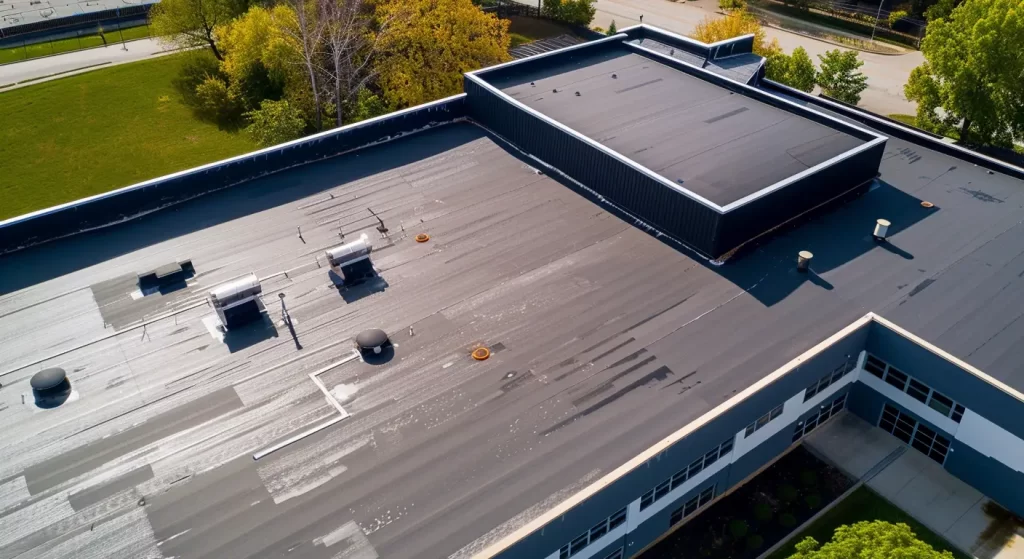
Built-Up, TPO, and EPDM: Which Lasts Longer?
When comparing built-up, TPO, and EPDM roofing, consider their durability, superior seam strength, and lifespan. Built-up roofs typically offer the longest life, while TPO provides energy efficiency. EPDM is known for its resilience in various climates but may require more maintenance over time.
Durability, Lifespan, and Maintenance Needs
Durability in roofing systems plays a critical role in long-term sustainability. Built-up roofs (BUR) typically boasts an impressive lifespan, often exceeding 20 years with low maintenance needs. Conversely, TPO and EPDM roof options offer robust options for different climates, with TPO’s reflective properties enhancing energy efficiency while EPDM’s weather resistance ensures durability. Regular inspection and maintenance are essential for all flat roofing materials to manage wear from UV radiation and extreme weather. Choosing the right roofing system significantly impacts long-term performance and cost-effectiveness.
Why Trust Shield Roofing?
Choosing Shield Roofing means opting for quality and reliability. We provide roofing service for over 25 years, and our extensive certifications—including being an Owens Corning preferred contractor, GAF certified, and holding a BBB A+ rating, as well as memberships in CTRCA and Directorii—ensure expert installation and maintenance tailored to your needs. Plus, our unwavering commitment to customer satisfaction guarantees a flat roof project that stands the test of time. We work with trusted brands like Owens Corning and GAF, and our goal is simple: roofs built tough! Built to last!
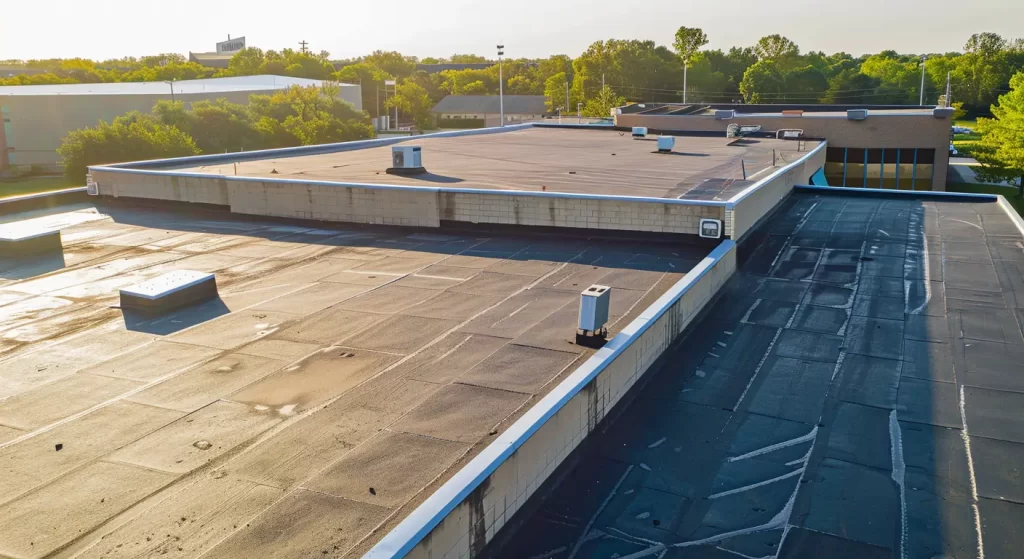
Trust the Experts
In evaluating the various roofing materials, it is evident that each option presents distinct advantages and challenges. EPDM roofing systems, with their durability and energy efficiency, are particularly suitable for specific climates, while TPO offers remarkable reflective properties and ease of installation. Building owners must consider their unique needs, including their specific needs regarding long-term performance and maintenance requirements, before making a decision. Ultimately, understanding the key differences between Built-Up, TPO, and EPDM roofing will empower property owners to choose the best fit for their commercial roofing projects.
Read our blog: How to Temporarily Patch a Roof Leak Before Pros Arrive
Frequently Asked Questions
How do weather conditions in San Antonio affect flat roofs?
In San Antonio, flat roofs face unique challenges due to extreme heat, humidity, and occasional storms. These weather conditions can lead to accelerated wear and tear, affecting materials like TPO and EPDM differently. Proper maintenance and material choice are crucial for longevity in this climate.
What kind of maintenance does each flat roof type require?
Built-up roofing (BUR) requires periodic inspections and re-coating, while TPO needs occasional cleaning and TPO seams repairs. EPDM typically demands minimal maintenance, mostly involving regular checks for punctures or tears. Each type’s longevity significantly depends on the attention given to these maintenance tasks.
